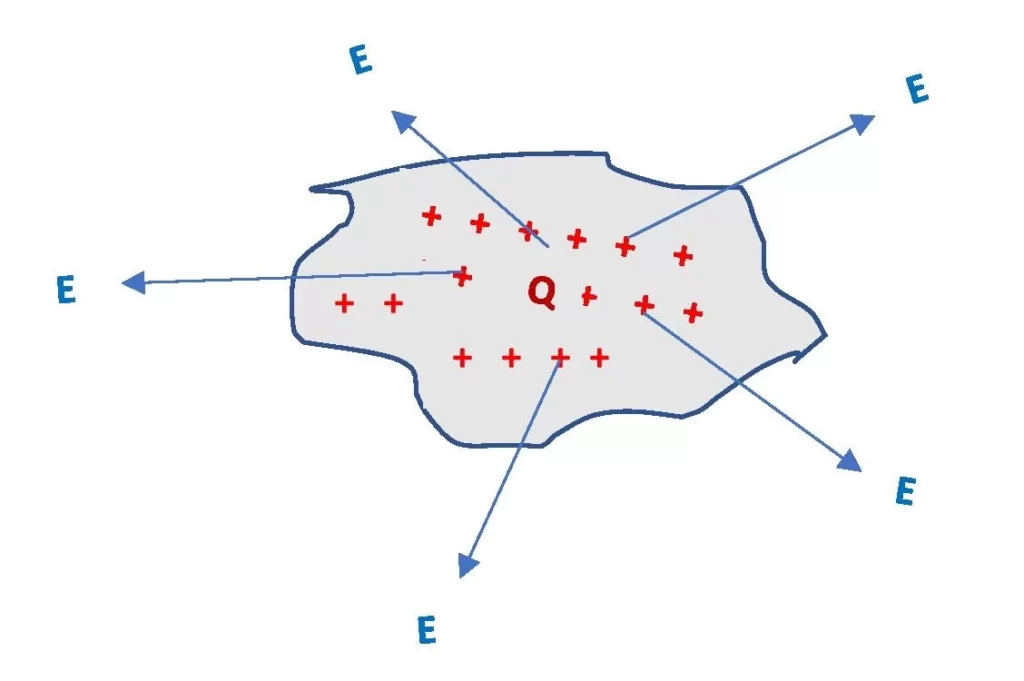If a body has an unequal number of protons and electrons then we call it a charged body. It can have either positive charges or negative charges. Either type of charge can produce an electric field near it. The amount of charges and the shape of the body determine the type and value of the electric field that the body will produce near it. Therefore, a new physical quantity is introduced in terms of the charge and dimension of a body which is called the charge density.

The distribution of charges on a conductor can take place in three ways – along the length, over the surface and in the volume. Therefore, a body can have three types of charge densities –
These are discussed in detail in other articles. Here I have written formulae only with a little explanation.
Charge Density Formula in Physics
The density of charge is equal to the amount of electric charges per unit dimension. The dimension can be any among the length, area and volume depending upon the shape of the body.
Charge Density = Electric Charge per dimension
All three charge densities have different formulae which are listed below.
Linear Charge density and its Formula
The density of charge of a linear body is measured in terms of linear charge density. It gives the electric charges distributed per meter or centimeter. Its symbol is \color{Blue}\lambda.
If a conductor of length L has total charge Q then the formula of its linear charge density is \color{Blue}\lambda = \frac{Q}{L}…………(1)
Surface Charge Density and its Formula
The distribution of charge on a body having a finite surface area is represented by the term surface charge density. It indicates the quantity of electric charges per unit surface area (m2 or cm2). It has the symbol of \color{Blue}\sigma.
If a conductor has total charge Q on its surface area A then the formula of its surface charge density is \color{Blue}\sigma = \frac{Q}{A}…………(2)
Volume Charge Density and its Formula
Conductors with 3D shapes can have electric charges in their volume. The volume charge density of such conductors is equal to the amount of electric charges per m3 or cm3. The symbol is \color{Blue}\rho.
For a conductor of charge Q and volume V, the formula of volume charge density is \color{Blue}\rho = \frac{Q}{V}…………(3)
Examples to find the charge density of a conductor
1. A solid cylindrical rod of length 2 meters and radius 0.5 meters has a total charge of 30 mC. Find its charge densities.
The rod is solid and thick enough. Therefore it has a finite length, area and volume. That means it can have all three types of charge densities.
Linear charge density, \color{Blue}\lambda = \frac{Q}{L}
or, \color{Blue}\lambda = \frac{30}{2}
or, \color{Blue}\lambda = 15 mC/meter ……..(Answer)
The surface area of the curved surface = \color{Blue}2\pi rL = 6.28 m2
Surface area of each two flat surfaces = \color{Blue}\pi r^2 = 0.785 m2
Charge density on curved surface = \color{Blue}\frac{Q}{2\pi rL} = \color{Blue}\frac{30}{6.28} = 4.78 mC/m2……..(Answer)
Charge density on flat surfaces = \color{Blue}\frac{Q}{\pi r^2} = \color{Blue}\frac{30}{0.785} = 38.22 mC/m2……(Answer)
The volume of the cylinder is \color{Blue} V =\pi r^2 L = 1.57 m3.
Then the volume charge density = \color{Blue}\frac{Q}{\pi r^2 L} = \color{Blue}\frac{30}{1.57} = 19.11 mC/m3……(Answer)
2. An irregularly shaped conductor has a total charge of 30 \mu C on its area of 1.5 square meters. What is its surface density of charge?
Surface charge density, \color{Blue}\sigma = \frac{Q}{A}
or, \color{Blue}\sigma = \frac{30}{1.5}
or, \color{Blue}\sigma = 20 \mu C.m^-2………..(Answer)
This is all from this article. Hope you will be able to find charge density after reading this post.
Thank you!
Related posts:
- Electrostatic charge distributions
- Linear charge density
- Surface Charge density of Sphere, Cylinder and Capacitor
- Volume charge density of Sphere, Cylinder, etc.